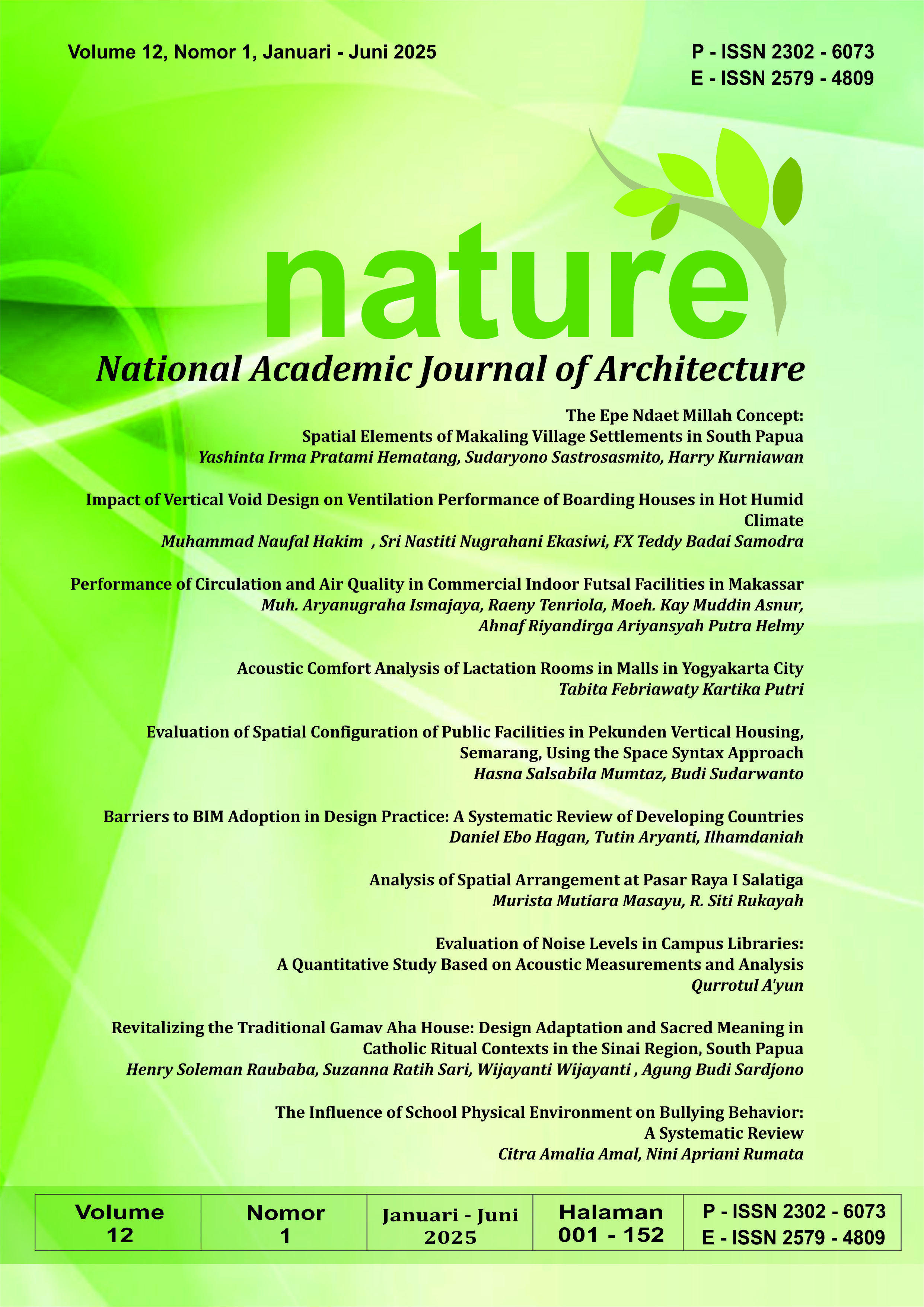Revitalizing the Traditional Gamav Aha House: Design Adaptation and Sacred Meaning in Catholic Ritual Contexts in the Sinai Region, South Papua
DOI:
https://doi.org/10.24252/nature.v12i1a9Keywords:
Vernacular Architecture Revitalization, Adaptive Design, Sacred Space, Malind Anim, Gamav Aha, South PapuaAbstract
The revitalization of the traditional Gamav Aha house as a sacred space within Catholic ritual practice has become a central issue in the cultural and religious life of the Malind Anim community in the Sinai area of South Papua. The disappearance of Gamav Aha due to modernization has threatened not only the sustainability of tangible heritage but also the collective meaning and cultural identity of the community. This study aimed to analyze the process of revitalizing Gamav Aha as a sacred space through design adaptation, functional transformation, and meaning negotiation within the context of Catholic rituals. A qualitative descriptive method was employed, and fieldwork was conducted in July 2024 across three main villages in the Sinai area: Urumb, Waninggap Nanggo, and Matara. Data were collected through participatory observation, in-depth interviews with traditional, religious, and community leaders, and visual documentation of spaces and ritual activities. The findings showed that revitalization was realized through innovations in physical design, including adjustments in layout, structure, materials, and spatial orientation. The transformation of Gamav Aha from a dwelling into a temporary sacred space, enriched with cultural and religious symbolism, strengthened community identity. These results underscore the importance of adaptive design strategies rooted in local wisdom for the preservation of vernacular architecture and the reinforcement of social cohesion within indigenous communities in the modern era.
Downloads
References
Ahlaro, Steven Ronald. (2019). Konsep Keallahan Malind Anim Serta Dampaknya Terhadap Upaya Penyebaran Ajaran Gereja Katolik di Wilayah Papua Selatan. Jurnal Jumpa Vol. VII, Edisi Khusus, Januari 2019.
Barrie, T. (2012). Sacred Space and The Mediating Roles of Architecture. European Review, 20(1), 79-94.
Bevans, S. B. (2002). Models of Contextual Theology. Maryknoll, NY: Orbis Books.
Blumer, H. (1969). Symbolic Interactionism: Perspective and Method. University of California Press.
Bokser, B. M. (1985). Approaching Sacred Space. Harvard Theological Review, 78(3-4), 279-299.
Braun, V., & Clarke, V. (2006). Using Thematic Analysis in Psychology. Qualitative Research in Psychology, 3(2), 77–101.
Creswell, J. W. (2014). Research Design: Qualitative, Quantitative, and Mixed Methods Approaches. SAGE Publications.
Daeli, F. F., & Silitonga, S. (2023). Kajian Pola Ruang dan Liturgi Dalam Gereja Katolik. ALUR: Jurnal Arsitektur, 6(1), 57-63.
Fauziah, N. (2014). Karakteristik Arsitektur Tradisional Papua.
Geertz, C. (1973). The Interpretation of Cultures. New York: Basic Books.
Guest, G., Bunce, A., & Johnson, L. (2006). How many interviews are enough? An experiment with data saturation and variability. Field methods, 18(1), 59-82.
Kvale, S., & Brinkmann, S. (2015). InterViews: Learning the Craft of Qualitative Research Interviewing. Sage.
Lake, R. C., Dwisusanto, Y. B., Purbadi, Y. D., & Arinto, F. (2020). Fenomena The Sacred Public Space Berdasarkan Teori Lefebvre “The Production of Space” Studi Kasus: Ruang Publik Kota Larantuka Sebagai Citra Kota Reinha Rosari. ARCADE: jurnal Arsitektur, 4(2), 85-93.
Lefebvre, H. (1991). The Production of Space. Wiley Blackwell.
Lincoln, Y. S., & Guba, E. G. (1985). Naturalistic Inquiry. Sage.
Mazumdar, S., & Mazumdar, S. (2004). Religion and Place Attachment: A study of Sacred Places. Journal of environmental psychology, 24(3), 385-397.
Naing, N. (2019). Makna Ruang Sakral pada Tata Ruang Dalam Rumah Panggung Tradisional Bugis. Jurnal Permukiman, 14(2), 137-150.
Namsa, V. E., (2023). Peringatan HUT ke-118 Misi Katolik di Keuskupan Agung Merauke. https://www.odiyaiwuu.com/peringatan-katolik-keuskupan/
Ocalan, M. (2024). Postures of the Architectural Object Before and After Inter-Religious Conversion. Sacred transfigurations: Churches-Mosques. Argument, 16, 78-101.
Oliver, P. (2007). Built to meet needs: Cultural Issues in Vernacular Architecture. London: Routledge.
Pramestisari, N. A. S., Kebayatini, N. L. N., & Putra, K. A. D. (2023). Komodifikasi Nilai Kesakralan (Transformasi Fungsi Ruang Dalam Perspektif Heterotopia di Pura Dalem Ped). Politicos: Jurnal Politik Dan Pemerintahan, 3(1), 59-75.
Ramadhana, D., & Dharoko, A. (2018). Ruang Sakral Dan Profan Dalam Arsitektur Masjid Agung Demak, Jawa Tengah. INERSIA lnformasi dan Ekspose Hasil Riset Teknik Sipil dan Arsitektur, 14(1), 13-25.
Raubaba, H. S., & Prianto, E. (2024). Desain dan Orientasi Arah Hadap Rumah Tradisional Malind Anim dalam Konteks Perubahan Iklim. Nature: National Academic Journal of Architecture, 11(2), 208-227. https://doi.org/10.24252/nature.v11i2a7
Rose, G. (2022). Visual Methodologies: An Introduction to Researching with Visual Materials (4th ed.). Sage.
Schreiter, R. J. (1985). Constructing Local Theologies. Maryknoll, NY: Orbis Books.
Soemalyo, Y. (2001). Arsitektur Tradisional/Primitif, diktat mata kuliah Perkembangan Arsitektur 1. Makassar: Laboratorium Sejarah dan Perkembangan Arsitektur Jurusan Arsitektur. Fakultas Teknik Universitas Hasanuddin.
Soedhijanto, P., Elaine, G., Hillary, A., Amadeo, L., Hariyanti, A.D. (2023). The Climate Impact Towards Form Materials and Construction of Papua Vernacular Houses. Jurnal Lakar, Vol. 06 No. 02 p. 175-188. DOI: 10.30998/lja.v6i2.16615
Sugiyono. (2008). Metode Penelitian Kuantitatif, Kualitatif, dan Kombinasi (Mixed Methods). Bandung: Alfabeta. 1-456
Thiessen, J., & McAlpine, B. (2013). Sacred Space: Function and Mission from a Sociological and Theological Perspective. International journal for the Study of the Christian Church, 13(2), 133-146.
Timbang, G., & Setiawan, A. (2019). Ruang Sakral Permukiman Tradisional Mamasa. Ruang: Jurnal Arsitektur, 13(2 September), 67-77.
Van Baal, Jan (1966). Dema. Description and Analysis of Marind-Anim Culture (South New Guinea). The Hague: Martinus Nijhoff.
Van Leeuwen, T., & Jewitt, C. (Eds.). (2000). The Handbook of Visual Analysis. Sage.
Wardani, S. (2006). Simbolisme Liturgi Ekaristi dalam Gereja Katolik: Sebuah Konsepsi dan Aplikasi. Journal of Liturgical Studies, 8(2), 34–48.
Yin, R. K. (2018). Case Study Research: Design and Methods (6th ed). Thousand Oaks. CA: SAGE.
Downloads
Published
How to Cite
Issue
Section
License
Copyright (c) 2025 Henry Soleman Raubaba, Suzanna Ratih Sari, Wijayanti Wijayanti , Agung Budi Sardjono

This work is licensed under a Creative Commons Attribution-ShareAlike 4.0 International License.
By submitting your manuscript to our journal, you are following Copyright and License






















